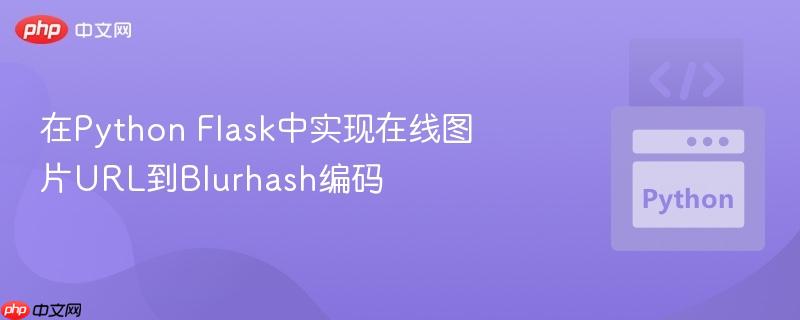
本教程详细介绍了如何在python flask应用中,将在线图片url转换为blurhash键。针对官方文档主要侧重本地文件处理的局限,文章通过整合`requests`库下载图片内容和`blurhash-python`库进行编码,提供了完整的解决方案,并包含代码示例、依赖安装、错误处理及在flask框架中的集成方法,旨在帮助开发者高效生成图片占位符。
Blurhash是一种紧凑的图片占位符编码格式,它能将一张图片的模糊版本表示为一个短字符串。这个字符串可以在客户端快速解码并显示为低分辨率的占位图,从而在图片加载完成前提供视觉反馈,优化用户体验。在Web开发中,尤其是在使用Python Flask构建后端服务时,我们经常需要处理来自各种在线URL的图片。然而,官方的Blurhash Python库示例通常只展示了如何处理本地图片文件,这给处理在线图片带来了困扰。本教程将解决这一常见问题,提供一个完整的方案,实现在Python Flask中将在线图片URL转换为Blurhash键。
要实现将在线图片URL转换为Blurhash键,我们需要两个主要的Python库:
您可以通过pip安装这些库:
pip install requests blurhash Pillow
blurhash-python库的encode函数通常接受一个文件对象(以二进制模式打开)或一个PIL Image对象。对于在线图片URL,我们不能直接将其路径传递给encode函数。解决方案是先通过requests库将图片内容下载到内存中,然后将其包装成一个文件状对象,或直接使用PIL打开其二进制数据,再传递给blurhash.encode。
立即学习“Python免费学习笔记(深入)”;
使用requests库的get方法可以方便地下载URL指向的资源。我们需要获取其二进制内容。
import requests
import io
def download_image_from_url(image_url):
"""
从指定的URL下载图片内容。
Args:
image_url (str): 图片的URL。
Returns:
io.BytesIO: 包含图片二进制数据的内存文件对象,如果下载失败则返回None。
"""
try:
response = requests.get(image_url, stream=True, timeout=10)
response.raise_for_status() # 检查HTTP请求是否成功
image_data = io.BytesIO(response.content)
return image_data
except requests.exceptions.RequestException as e:
print(f"下载图片失败: {e}")
return None获取到图片数据的内存文件对象后,我们可以将其传递给blurhash.encode函数。
import blurhash
from PIL import Image # blurhash-python 内部可能使用Pillow,直接用PIL打开更稳健
def generate_blurhash_from_image_data(image_data_io, x_components=4, y_components=3):
"""
从图片二进制数据生成Blurhash键。
Args:
image_data_io (io.BytesIO): 包含图片二进制数据的内存文件对象。
x_components (int): Blurhash编码的X轴分量数量。
y_components (int): Blurhash编码的Y轴分量数量。
Returns:
str: 生成的Blurhash键,如果编码失败则返回None。
"""
try:
# blurhash.encode 可以直接接受文件对象,但使用PIL.Image.open更明确
# 确保图片数据是有效的图像文件
img = Image.open(image_data_io)
# blurhash.encode 也可以直接接受PIL Image对象
hash_key = blurhash.encode(img, x_components, y_components)
return hash_key
except Exception as e:
print(f"生成Blurhash失败: {e}")
return None现在,我们可以将上述逻辑整合到一个Flask路由中,创建一个API接口,接收图片URL并返回其Blurhash键。
from flask import Flask, request, jsonify
import requests
import io
import blurhash
from PIL import Image
app = Flask(__name__)
# 辅助函数:从URL下载图片
def download_image_from_url(image_url):
try:
response = requests.get(image_url, stream=True, timeout=10)
response.raise_for_status()
return io.BytesIO(response.content)
except requests.exceptions.RequestException as e:
print(f"下载图片失败: {e}")
return None
# 辅助函数:从图片数据生成Blurhash
def generate_blurhash_from_image_data(image_data_io, x_components=4, y_components=3):
try:
img = Image.open(image_data_io)
hash_key = blurhash.encode(img, x_components, y_components)
return hash_key
except Exception as e:
print(f"生成Blurhash失败: {e}")
return None
@app.route('/get_blurhash', methods=['GET'])
def get_blurhash():
image_url = request.args.get('url')
if not image_url:
return jsonify({"error": "请提供图片URL参数"}), 400
# 可选:验证URL格式,防止恶意请求
if not (image_url.startswith('http://') or image_url.startswith('https://')):
return jsonify({"error": "无效的图片URL格式"}), 400
x_components_str = request.args.get('x', '4')
y_components_str = request.args.get('y', '3')
try:
x_components = int(x_components_str)
y_components = int(y_components_str)
if not (1 <= x_components <= 9 and 1 <= y_components <= 9):
raise ValueError("x_components和y_components必须在1到9之间")
except ValueError as e:
return jsonify({"error": f"无效的x或y分量参数: {e}"}), 400
image_data_io = download_image_from_url(image_url)
if image_data_io is None:
return jsonify({"error": "无法下载图片或图片URL无效"}), 500
blurhash_key = generate_blurhash_from_image_data(image_data_io, x_components, y_components)
if blurhash_key is None:
return jsonify({"error": "无法生成Blurhash,请检查图片内容"}), 500
return jsonify({"url": image_url, "blurhash": blurhash_key})
if __name__ == '__main__':
# 示例用法:
# 启动Flask应用后,在浏览器中访问:
# http://127.0.0.1:5000/get_blurhash?url=https://www.example.com/your_image.jpg
# 或者带上分量参数:
# http://127.0.0.1:5000/get_blurhash?url=https://www.example.com/your_image.jpg&x=5&y=4
app.run(debug=True)本教程提供了一个在Python Flask中将在线图片URL转换为Blurhash键的全面解决方案。通过结合requests库下载图片内容和blurhash-python库进行编码,我们克服了官方文档的局限性,并提供了一个可直接在Flask应用中使用的API接口。遵循文中提到的注意事项和最佳实践,您可以构建一个健壮、高效且安全的图片占位符生成服务,从而提升您应用的整体用户体验。
以上就是在Python Flask中实现在线图片URL到Blurhash编码的详细内容,更多请关注php中文网其它相关文章!

每个人都需要一台速度更快、更稳定的 PC。随着时间的推移,垃圾文件、旧注册表数据和不必要的后台进程会占用资源并降低性能。幸运的是,许多工具可以让 Windows 保持平稳运行。

Copyright 2014-2025 https://www.php.cn/ All Rights Reserved | php.cn | 湘ICP备2023035733号